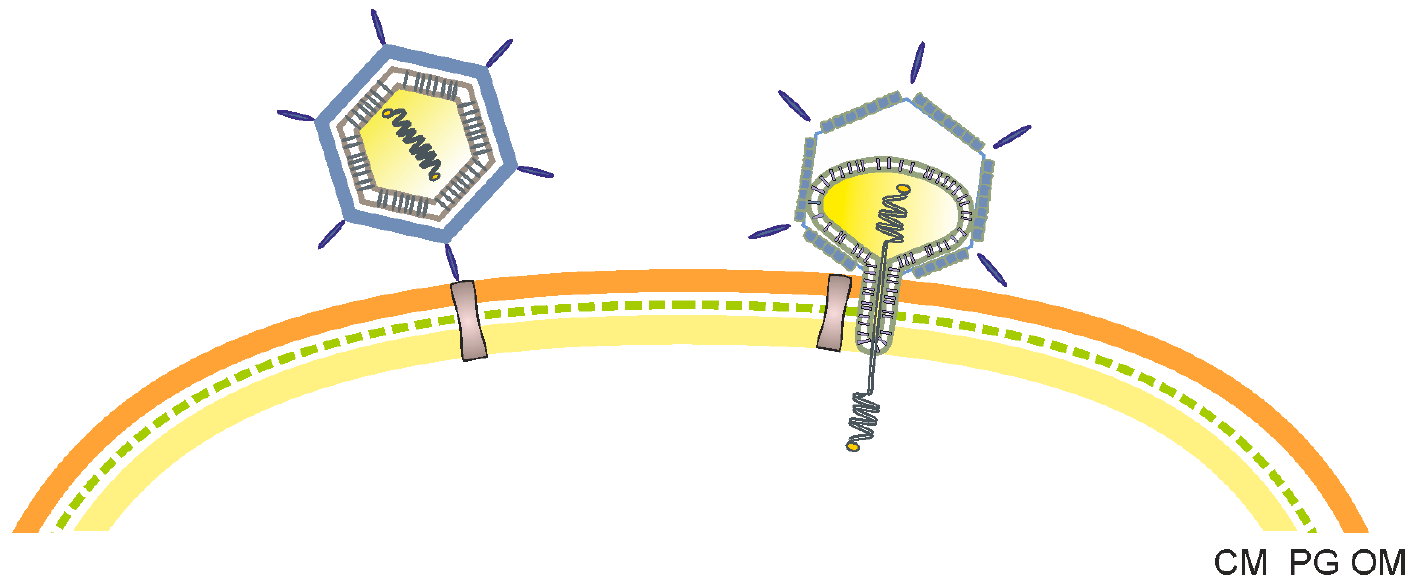Tectivirus on:
[Wikipedia]
[Google]
[Amazon]
''Tectiviridae'' is a family of
 The
The
Unclassified Tectiviridae
NCBI Taxonomy. * Thermus virus phiKo * Microbacterium virus Badulia *
ICTVdB—The Universal Virus Database
ICTVdB Management (2006). 00.068. Tectiviridae. In: ICTVdB—The Universal Virus Database, version 3. Büchen-Osmond, C. (Ed), Columbia University, New York, USA
Eighth Report of the International Committee on Taxonomy of Viruses H.V. Van Regenmortel, D.H.L. Bishop, M. H. Van Regenmortel, Claude M. Fauquet (Eds)
ICTV
{{Taxonbar, from=Q569755 Bacteriophages
viruses
A virus is a submicroscopic infectious agent that replicates only inside the living cells of an organism. Viruses infect all life forms, from animals and plants to microorganisms, including bacteria and archaea. Viruses are found in almo ...
with 12 species in five genera. Bacteria serve as natural hosts. Tectiviruses have no head-tail structure, but are capable of producing tail-like tubes of ~ 60×10 nm upon adsorption or after chloroform
Chloroform, or trichloromethane (often abbreviated as TCM), is an organochloride with the formula and a common solvent. It is a volatile, colorless, sweet-smelling, dense liquid produced on a large scale as a precursor to refrigerants and po ...
treatment. The name is derived from Latin
Latin ( or ) is a classical language belonging to the Italic languages, Italic branch of the Indo-European languages. Latin was originally spoken by the Latins (Italic tribe), Latins in Latium (now known as Lazio), the lower Tiber area aroun ...
''tectus'' (meaning 'covered').
Virology
 The
The virion
A virion (plural, ''viria'' or ''virions'') is an inert virus particle capable of invading a Cell (biology), cell. Upon entering the cell, the virion disassembles and the genetic material from the virus takes control of the cell infrastructure, t ...
s of ''Tectiviridae'' species are non-enveloped, icosahedral and display a pseudo T=25 symmetry. The capsid
A capsid is the protein shell of a virus, enclosing its genetic material. It consists of several oligomeric (repeating) structural subunits made of protein called protomers. The observable 3-dimensional morphological subunits, which may or m ...
has two layers. The outer layer is a protein structure of 240 capsid proteins trimers, and the inner one is a proteinaceous lipid membrane which envelopes the virus genome
A genome is all the genetic information of an organism. It consists of nucleotide sequences of DNA (or RNA in RNA viruses). The nuclear genome includes protein-coding genes and non-coding genes, other functional regions of the genome such as ...
. Apical spikes extending about 20 nanometer
330px, Different lengths as in respect to the Molecule">molecular scale.
The nanometre (international spelling as used by the International Bureau of Weights and Measures; SI symbol: nm), or nanometer (American spelling
Despite the va ...
s (nm) protrude from the icosahedrons vertices.
The genome is a single molecule of linear double-stranded DNA
Deoxyribonucleic acid (; DNA) is a polymer composed of two polynucleotide chains that coil around each other to form a double helix. The polymer carries genetic instructions for the development, functioning, growth and reproduction of al ...
of 15 kilo bases in length, and has 30 open reading frames. It forms a tightly packed coil and encodes several structural proteins. It encodes about 30 proteins that are transcribed in operons. At least 9 structural proteins are present in the viron. The genome is about 66 mega daltons in weight and constitutes 14–15% of the virion by weight. Lipid
Lipids are a broad group of organic compounds which include fats, waxes, sterols, fat-soluble vitamins (such as vitamins A, D, E and K), monoglycerides, diglycerides, phospholipids, and others. The functions of lipids include storing ...
s constitute a further 15% by weight. Carbohydrate
A carbohydrate () is a biomolecule composed of carbon (C), hydrogen (H), and oxygen (O) atoms. The typical hydrogen-to-oxygen atomic ratio is 2:1, analogous to that of water, and is represented by the empirical formula (where ''m'' and ''n'' ...
s are not present.
Life cycle
Viral replication is cytoplasmic. Entry into the host cell is achieved by adsorption into the host cell. After adsorption to the host cell surface the virion extrudes a tail-tube structure through a vertex for genome delivery into the host. Replication follows the DNA strand displacement model. DNA-templated transcription is the method of transcription. Capsid proteins polymerize around a lipoprotein vesicle translocated in the cytoplasm by virion assembly factors. Mature virons are released by lysis, which, in the case of PRD1, is achieved with the aid of virus-encoded lysis machinery consisting of four proteins: P15 ( endolysin), P35 (holin), P36 and P37 (homologues of the Rz/Rz1 proteins of phage lambda).Taxonomy
''Tectiviridae'' contains the following genera and species: * '' Alphatectivirus'' ** '' Alphatectivirus PR4'' ** '' Alphatectivirus PRD1'' * '' Betatectivirus'' ** '' Betatectivirus AP50'' ** '' Betatectivirus Bam35'' ** '' Betatectivirus GIL16'' ** '' Betatectivirus sato'' ** '' Betatectivirus sole'' ** '' Betatectivirus Wip1'' * '' Deltatectivirus'' ** '' Deltatectivirus forthebois'' ** '' Deltatectivirus wheeheim'' * '' Epsilontectivirus'' ** '' Epsilontectivirus toil'' * '' Gammatectivirus'' ** '' Gammatectivirus GC1'' Other unassigned phages:NCBI Taxonomy. * Thermus virus phiKo * Microbacterium virus Badulia *
Microbacterium virus MuffinTheCat
Microbacterium virus MuffinTheCat is a species of bacteriophage in the Family (biology), family Tectivirus, Tectiviridae. It was collected and identified by Darcy Reimer on 1 October 2019. It is part of the Microbacterium testaceum NRRL B-24232, ...
References
Further reading
ICTVdB—The Universal Virus Database
ICTVdB Management (2006). 00.068. Tectiviridae. In: ICTVdB—The Universal Virus Database, version 3. Büchen-Osmond, C. (Ed), Columbia University, New York, USA
Eighth Report of the International Committee on Taxonomy of Viruses H.V. Van Regenmortel, D.H.L. Bishop, M. H. Van Regenmortel, Claude M. Fauquet (Eds)
External links
ICTV
{{Taxonbar, from=Q569755 Bacteriophages